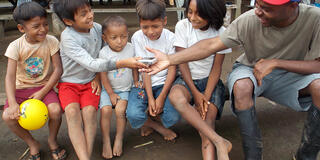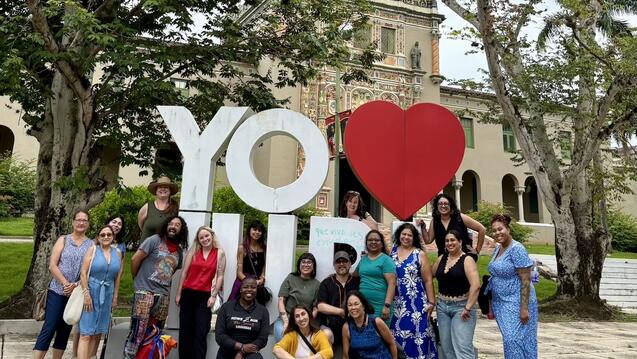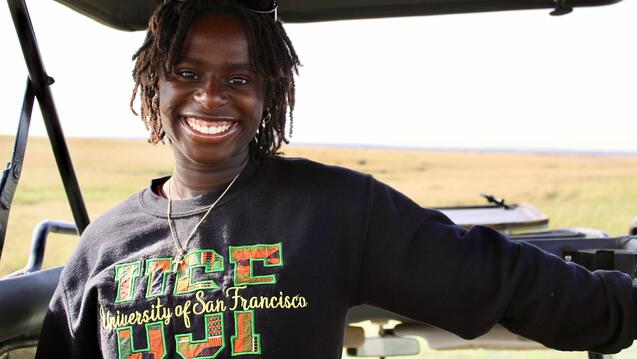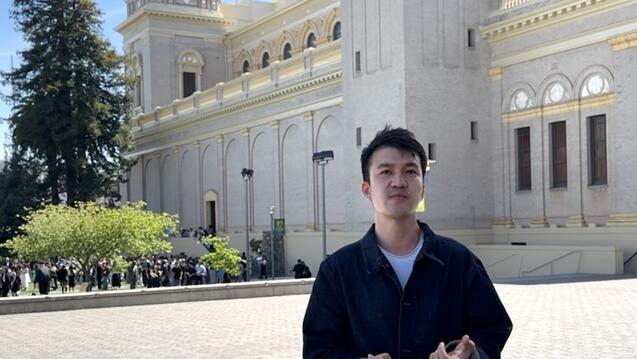USF Teachers, Students Ally With People of the Amazon

This summer, 12 graduate students from the University of San Francisco’s International and Multicultural Education (IME) Program traveled to the remote Amazon region of Morona Santiago, Ecuador, to build a bilingual curriculum for an ancient, indigenous people fighting for its survival.
The Achuar people lived almost untouched along the Ecuador-Peru border until the 1970s—avoiding the exploitation suffered by other tribes at the hands of rubber harvesters in the 1940s. Since then, however, even the Achuar’s remote corner of the world has begun to suffer from encroachment.
In response, the Achuar, who speak a dialect of Shuar and number about 7,000 dispersed in approximately 70 farming and hunting communities, convened an International English Minga—a Quechua word meaning “a call to collaboration”—in July. The Minga kicked off a campaign to raise awareness about the challenge to protect their culture and ancestral lands from a growing threat: development by multinational petroleum corporations.
The Achuar believe that learning English will help them communicate their message and culture to the outside world, build alliances, and spur economic development through ecotourism at the Achuar-owned and -operated Kapawi Ecolodge and Reserve. Kapawi was recognized as a top five eco-conservation and community development project by the United Nations in 2010.
The Minga is a watershed event for the Achuar, one that responds to a prophesy of one of the group’s powerful shamans that foresaw the need to form alliances with interested North Americans in order to fight encroachment.
“They are extremely excited about the potential for this [bilingual curriculum] program and how it can help their future,” said Susan Roberta Katz, professor in USF's master's in international and multicultural education and master's in human rights education programs. “People there see ecotourism as the key to their cultural survival because it provides an alternative to oil and mining exploitation—and the English language plays an important role in that.”
The Minga brought together North American and Achuar educators to create a first-of-its-kind English-Achuar curriculum for Achuar children that is based on Achuar myths, songs and dance, plants, cuisine, art, and community life.
Katz joined the cultural and educational exchange with the Achuar after visiting their territory in 2010 while she was completing a Fulbright to research another Ecuadorian indigenous people, the Shuar. Previously, Katz taught Indigenous Rights, the Environment, and Education in Ecuador, visiting indigenous communities that were negatively affected by or actively resisting oil or mining exploitation of their ancestral lands.
Onllwyn Dixon, IME adjunct professor, also joined the effort.
Pam Ly, an IME student who travelled to Ecuador with Katz and Dixon, called the trip incredible. “I am very grateful for this exceptional opportunity to work alongside the Achuar teachers to develop new teaching methodologies aimed at sustaining and preserving the Achuar culture,” said Ly, who will graduate in December.
USFers introduced storytelling, songs, and Total Physical Response (learning language through movement) as teaching tools, adding to Achuar teachers’ demonstration and lecture approach. In one instance, USFers worked with local teachers to adapt Shuar lyrics to well-known American children’s tunes and used body gestures to increase students' attention and participation.
During the three-week immersion, USFers lived alongside the Achuar, sleeping in tents on the ground of traditional thatched-roof homes, bathing in a nearby river, and making due without electricity, plumbing, or other conveniences. They also took part in daily practices such as drinking chicha (a local drink made from yucca) and observing sunrise guayasa tea ceremonies.
Know someone with a powerful USF story? Let us know! usfnews@usfca.edu | Twitter @usfca


